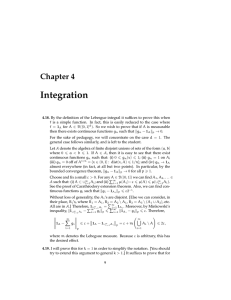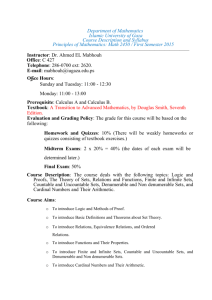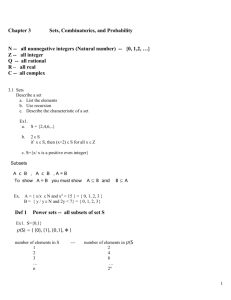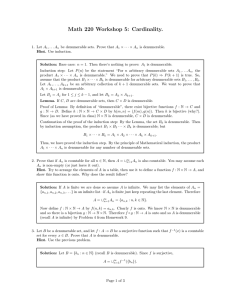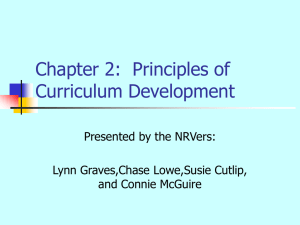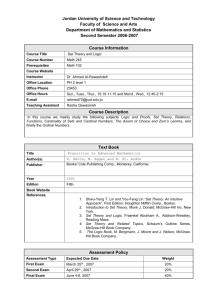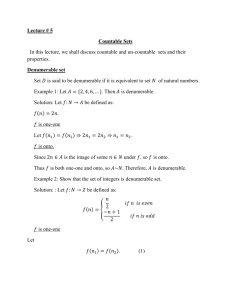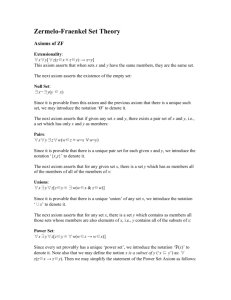MATH 200, Lec 2 Solutions to Midterm 2
advertisement
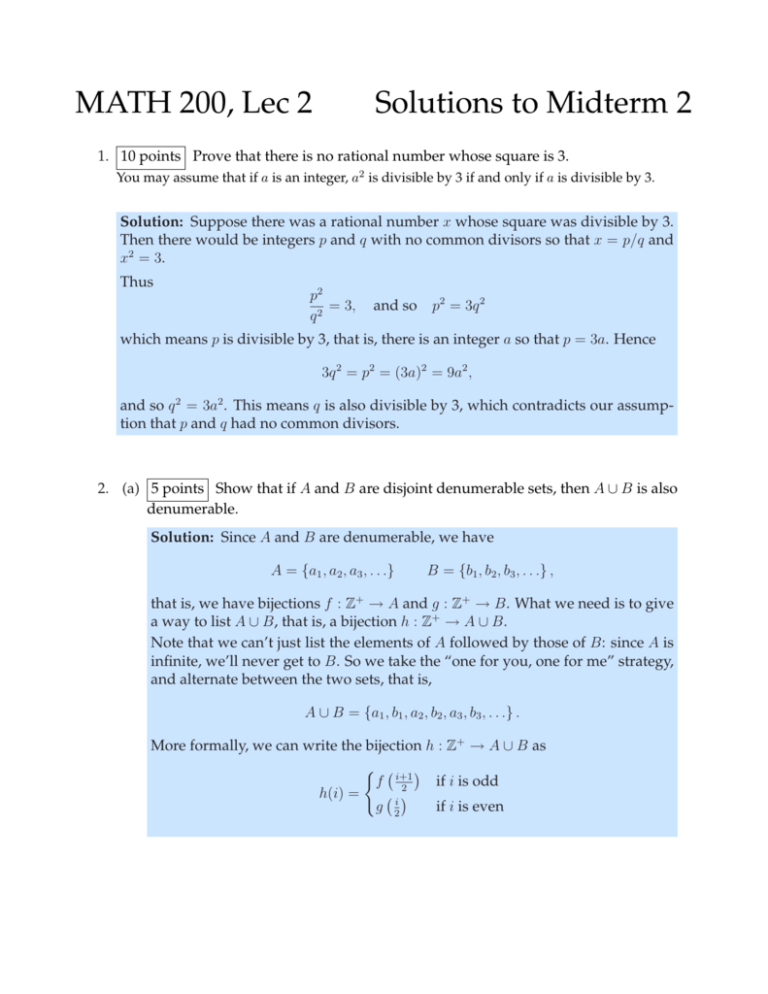
MATH 200, Lec 2
Solutions to Midterm 2
1. 10 points Prove that there is no rational number whose square is 3.
You may assume that if a is an integer, a2 is divisible by 3 if and only if a is divisible by 3.
Solution: Suppose there was a rational number x whose square was divisible by 3.
Then there would be integers p and q with no common divisors so that x = p/q and
x2 = 3.
Thus
p2
= 3,
q2
and so
p2 = 3q 2
which means p is divisible by 3, that is, there is an integer a so that p = 3a. Hence
3q 2 = p2 = (3a)2 = 9a2 ,
and so q 2 = 3a2 . This means q is also divisible by 3, which contradicts our assumption that p and q had no common divisors.
2. (a) 5 points Show that if A and B are disjoint denumerable sets, then A ∪ B is also
denumerable.
Solution: Since A and B are denumerable, we have
A = {a1 , a2 , a3 , . . .}
B = {b1 , b2 , b3 , . . .} ,
that is, we have bijections f : Z+ → A and g : Z+ → B. What we need is to give
a way to list A ∪ B, that is, a bijection h : Z+ → A ∪ B.
Note that we can’t just list the elements of A followed by those of B: since A is
infinite, we’ll never get to B. So we take the “one for you, one for me” strategy,
and alternate between the two sets, that is,
A ∪ B = {a1 , b1 , a2 , b2 , a3 , b3 , . . .} .
More formally, we can write the bijection h : Z+ → A ∪ B as
( ¡ ¢
f i+1
if i is odd
2
h(i) =
¡i¢
if i is even
g 2
Page 2 of 4
(b) 5 points Show that if X is an uncountable set and A ⊆ X is denumerable, then
the complement of A in X (that is, X − A) must be uncountable.
You may use the first part of this question, even if you couldn’t do it
Solution: We can do this by contradiction. If X − A is not uncountable, then it must
be countable, that is either finite or denumerable.
If X − A is denumerable, we have X expressed as the union of two denumerable
sets: X = A ∪ (X − A), and so by the first part of the problem, X is denumerable,
giving a contradiction.
Similarly, if X −A is finite, since A is denumerable, their union is again denumerable,
giving a contradition. (There is a theorem in the text to this effect. However, the
proof is simple: If |X − A| = n, then we can write X − A = {x1 , x2 , x3 , . . . , xn }, and
so X = {x1 , x2 , x3 , . . . , xn , a1 , a2 , a3 , . . .}.)
3. Three people decide to get tacos, and the tacqueria serves five kinds of tacos: beef,
chicken, pork, fish, and vegetarian. Each person orders exactly one taco.
(a) 5 points How many choices are possible if we record who selected which dish
(as the waiter should)?
Solution: Each person can choose one of five types of taco, so there are 5 · 5 · 5 =
53 = 125 possible choices for all three.
(b) 5 points How many choices are possible if we forget who ordered which dish
(as the chef might)?
Be careful, this is more complicated than it may seem at first.
Solution: Here there is a slight complication since more than one person might
order the same type of taco. We just count the three cases separately.
• First, if all three get the same type of taco, there are 5 possibilities.
• If two get the same type of taco, and one gets something else, we have 5
choices for the two that are the same, and 4 choices remain for the different
one. This gives us 20 possibilities.
¡¢
• Finally, if all three get different types, this means we have 53 = 10 possibilities.
Altogether, this gives us 5 + 20 + 10 = 35 different orders from the chef’s point
of view.
MATH 200, Lec 2: Solutions to Midterm 2
November 20, 2006
Page 3 of 4
9
12
4. 5 points What is the coefficent of x in the expansion of (x + 2) ?
Solution: We apply the binomial theorem, which tells us that the term involving x9
looks like
µ ¶
12 9 3
12! 9
x = 8 · 220x9 = 1760x9
x 2 =8
9
9!3!
so the coefficient of x9 is 1760.
5. 10 points Using only the definitions and axioms on the back of the cover sheet,
prove that if `, m, and n are lines so that ` is parallel to m, and m is parallel to n, then
` is parallel to n.
Solution: If ` = m, the result follows immediately, since ` k m.
Now suppose ` 6= m, so ` and m have no points in common. Either ` and n have
no points in common (in which case we are done, since then they are parallel), or
they share at least one point. Call this point P . Since ` and m are disjoint, P is not
on m, and so by the parallel axiom there is a unique line which is parallel to m and
passes through P . Since both ` and n are parallel to m and pass through P , the only
possibility is that they are equal. By the definition of parallel, if ` = n, then also
`/paralleln, as desired.
(You can also do this second part by contradiction. The argument is much the same.)
6. For each of the interpretations of the terms point, line, and distance given below, determine if they are consistent with the axioms given on the back of the cover sheet. If
the interpretation is not consistent, state all axioms it contradicts, and explain why.
A
(a) 5 points The plane contains exactly four points, A, B, C,
←→
←→
←→
←→
←→
and D. There are six lines: AB, AC, AD, BC, BD, and
←→
CD, and the distances between points are given
√ by |AD| =
|BD| = |CD| = 1 and |AB| = |BC| = |CA| = 3.
D
C
B
Solution: We’ll check each of the axioms in turn:
Incidence Axiom: Satisfied. Each line contains two points, each pair of points
lies on a unique line, and each line has at least one point not on it.
Parallel Axiom: Satified. For each line, there is another line which is disjoint
←→
←→
←→
←→
←→
←→
from it, and hence parallel. Specifically, ABkCD, ACkBD, and ADkBC.
Ruler Axiom: This one fails. Each line has only two points, and R is uncountable. So there is no possibility of a bijection of any of the lines with R.
MATH 200, Lec 2: Solutions to Midterm 2
November 20, 2006
Page 4 of 4
(b) 5 points Points are elements (x, y) ∈ R2 with −1 < x < 1. A line is the set of
points which satisfy y = mx+b where m and b are real numbers (and −1 < x < 1);
in addition, the points which satisfy x = a where −1 < a < 1
are also lines. The s
distance between two points (x1 , y1 ) and
µ
¶2
x1
x2
− 2
+ (y1 − y2 )2
(x2 , y2 ) is given by
2
x1 − 1 x2 − 1
Solution:
Incidence Axiom: As before, the incidence axiom holds. Given any two points
(x1 , y1 ) and (x2 , y2 ) in the strip, we can find a unique line passing through
them as follows: If x1 = x2 , then the line is x = x1 . Otherwise, the line has
the equation
y1 − y2
y − y1 =
(x − x1 )
x1 − x2
Each line contains infinitely many points, and for each line, there are plenty
of points not on it.
Parallel Axiom: This one fails. Here is a counterexample: Take the line y = 0,
and the point (0, 4). Then any line of the form y = mx+4 with −4 < m < 4
will pass through (0, 4) and be disjoint from y = 0 (and hence parallel to
it).
Ruler Axiom: The ruler axiom holds. The easy way to see this is to notice that
the
© given distance
ª formula “stretches horizontal distances” near the sets
(x, y) | x = ±1 . The transformation
µ
¶
©
ª
x
2
2
f : (x, y) ∈ R | − 1 < x < 1 → R given by f (x, y) =
,y
1 − x2
is a bijection of our strip with the regular plane R2 sending vertical lines
to vertical lines, and a line segment of the form y = mx + b (−1 < x < 1)
to a curve with horizontal asymptotes at y = m + b and y = −m + b. The
distance formula given just measures the distance (in R2 ) between points
on this curve.
7.5
7.5
5.0
5.0
f
−→
y
2.5
2.5
0.0
0.0
−1
y
0
1
−10
x
MATH 200, Lec 2: Solutions to Midterm 2
−5
0
5
10
x
November 20, 2006
